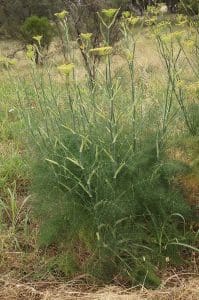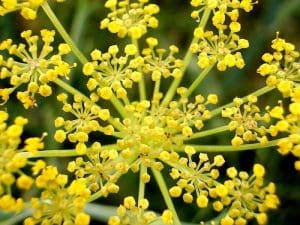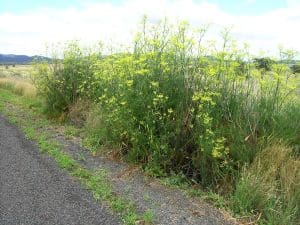Wild Fennel / Spring / Summer / Autumn / Edible
Latin Name:
Foeniculum vulgare
Physical Characteristics:
A tall umbellifer that can grow to 1.5-2m tall in favourable conditions.
Leaves
The leaves, which begin sheathed, are very finely branched and appear feathery. They have a strong aniseed smell when crushed

Flowers
The flowering stalks are round in the cross section, and the flowers are arranged in umbels with tiny yellow petals.

Seeds
The seeds are oval and striped.
Extra on Identification of Wild Fennel



Left: Fennel will form clumps that can dominate surrounding vegetation, particularly in disturbed or low nutrient areas. Middle: The classic umbel flower structure has yellow florets on fennel. Right: Note the incredibly fine laciness of the leaves, which have distinctive sheathes from which they grow. The only difference between dill and fennel is aroma.
Habitat, Range and Distribution:
Originally Fennel grew on mainland Europe and into Eurasia. It has been spread by cultural introduction, often by Italian emmigration patterns. It takes well to grassy, disturbed ground.
Conservation Considerations:
Like many of the other umbellifers that have been naturalised in the UK, Fennel does not struggle to establish itself. It is widely considered a weed, particularly because the taproots are very deep and tenacious It is not rare, but is a source of pollen for various pollinators.
Harvest Time and Techniques:
Gather with care for the entire ecosystem, only removing what you need with a sharp blade.
The young leaf shoots are incredibly succulent and aromatic in the spring, and the stems of fresh growth are delicious in late spring to early summer. Harvest the seeds as you like them (green to brown) in the autumn as they form – start looking out August – October.
Could Be Confused With, and Other Safety Notes:
There are many umbellifers in the UK, most of which are delicious, and others of which can see you end up in hospital.
They all have the radially dividing flower, the petals of which tend to be either white or yellow.
Make sure you get familiar with the super toxic, super common species (Hemlock and Hemlock Water Drop-Wort), and everything else should fall into place.
Smell is an important sense in the identification of umbellifers. Fennel smells definitely like fennel, and has its distinctive feathery leaves. The flowers are yellow, and the seeds are familiarly striped.
Edible Uses:
The flavour of Fennel is usually familiar to folks, being reminiscent of aniseed.
Note that wild Fennel does not produce a bulb like those available in vegetable shops.
The root of wild Fennel should not be consumed.
The leaves are a delicious herb, and complement vegetables and seafood particularly well. They can also be brewed into a mild digestive tea along with your other favourite flavours like Mint and Chamomile.
The seeds are more aromatic than the leaves and can be harvested green and allowed to dry, or when they are almost brown – decide how you like the taste. The flowers make a very pretty addition to salads or dishes as a garnish.
Apparently chefs prize the pollen from the flowers very highly for its intensity of taste – to collect your own grab the Fennel tops when they’re bright yellow and pop on a piece of paper to dry out and drop their bright yellow super flavoured pollen.
Medicinal Uses:
This is a wonderful digestive tonic herb. The seeds are usually used medicinally for all kinds of digestive upset like bloating, wind and mild pain, but also to maximise the milk flow of breastfeeding mothers.
Extra Tips and Fun Facts:
Fennel was naturalised in the UK by the Romans and has very successfully established itself here ever since.
Sources:
https://honest-food.net/playing-with-fennel/
https://www.wildlifetrusts.org/wildlife-explorer/wildflowers/fennel
https://www.growforagecookferment.com/foraging-for-wild-fennel/
2 replies on “Wild Fennel (Foeniculum vulgare) Identification”
Leave a Reply
You must be logged in to post a comment.






I was driving along a road among snow covered fields and saw something that reminded me of all the Wild Fennel all over Central California. Reminded me, mind you, it’s too frosty in Idaho to see the real stuff. Instead: The spindly, lanky limbs atop the leafless cottonwoods covered with hoar frost along the roads and among the fields look like silvery-white wild fennel umbels silhouetted against a luminous backdrop of gray clouds. Not exactly 2nd place to the real stuff, but reminiscent. I couldn’t remember the name for the flowerings, so I went a lookin’ and found you folks. Thanks
Wow, that sounds majestic 🙂